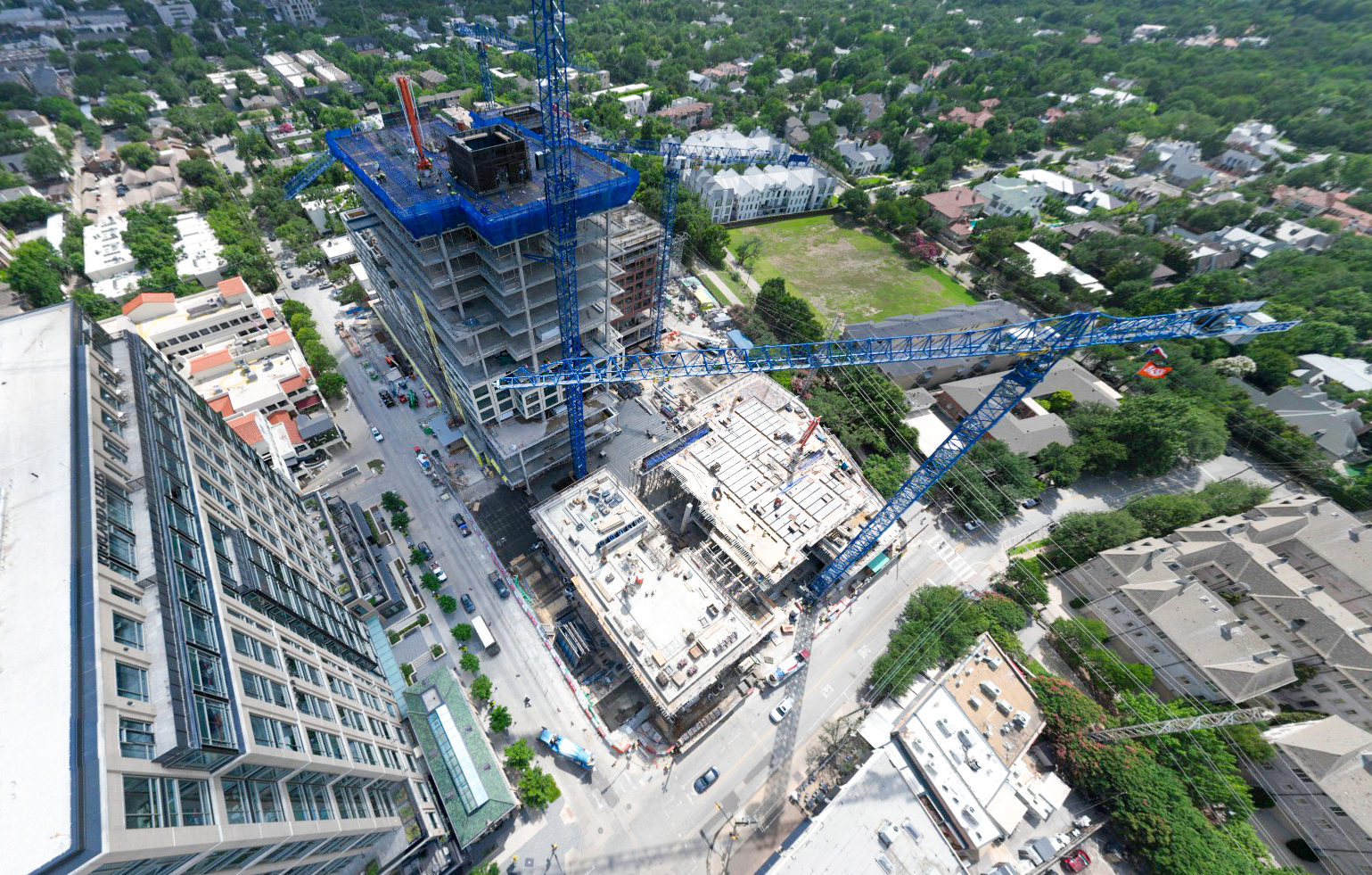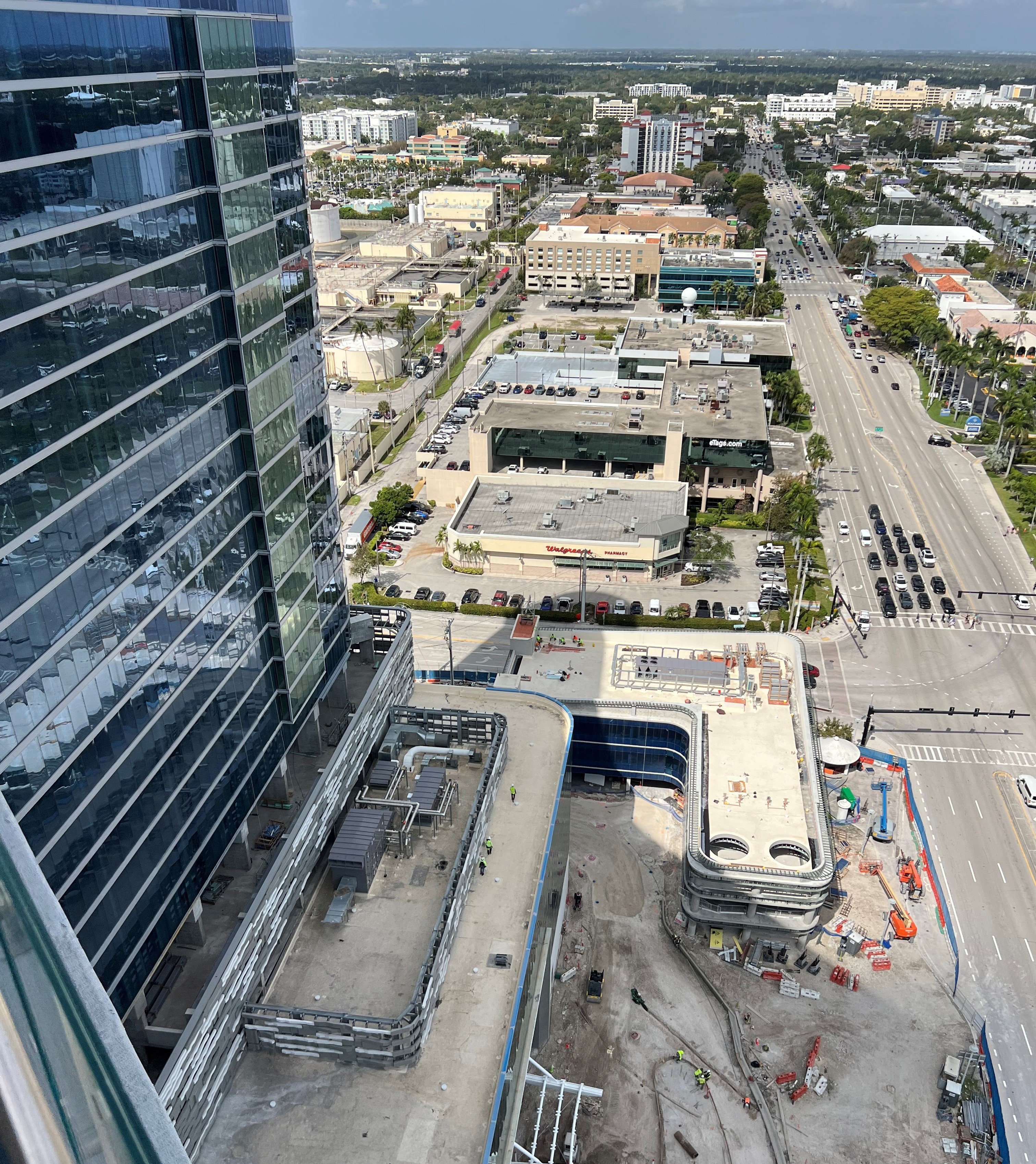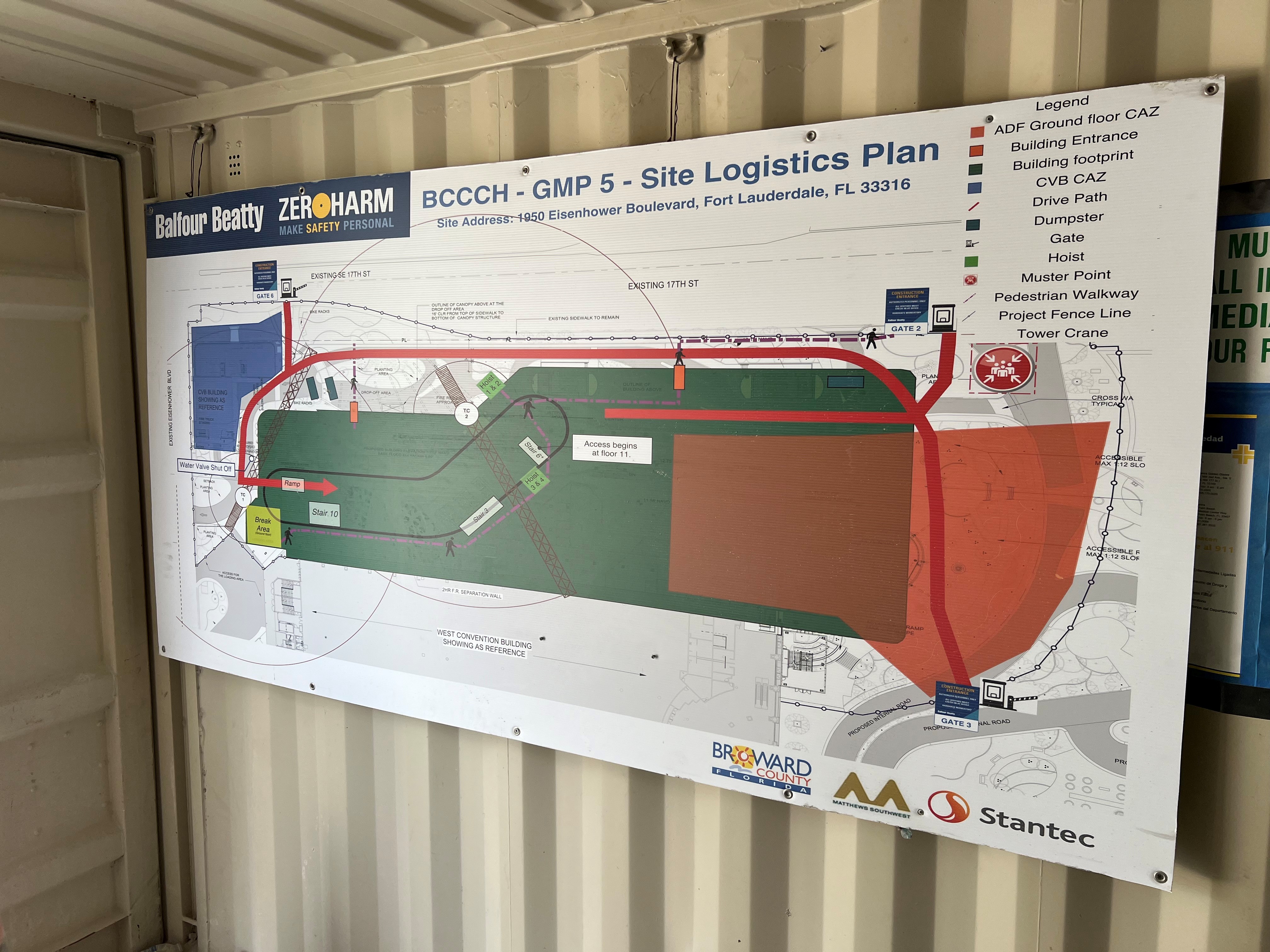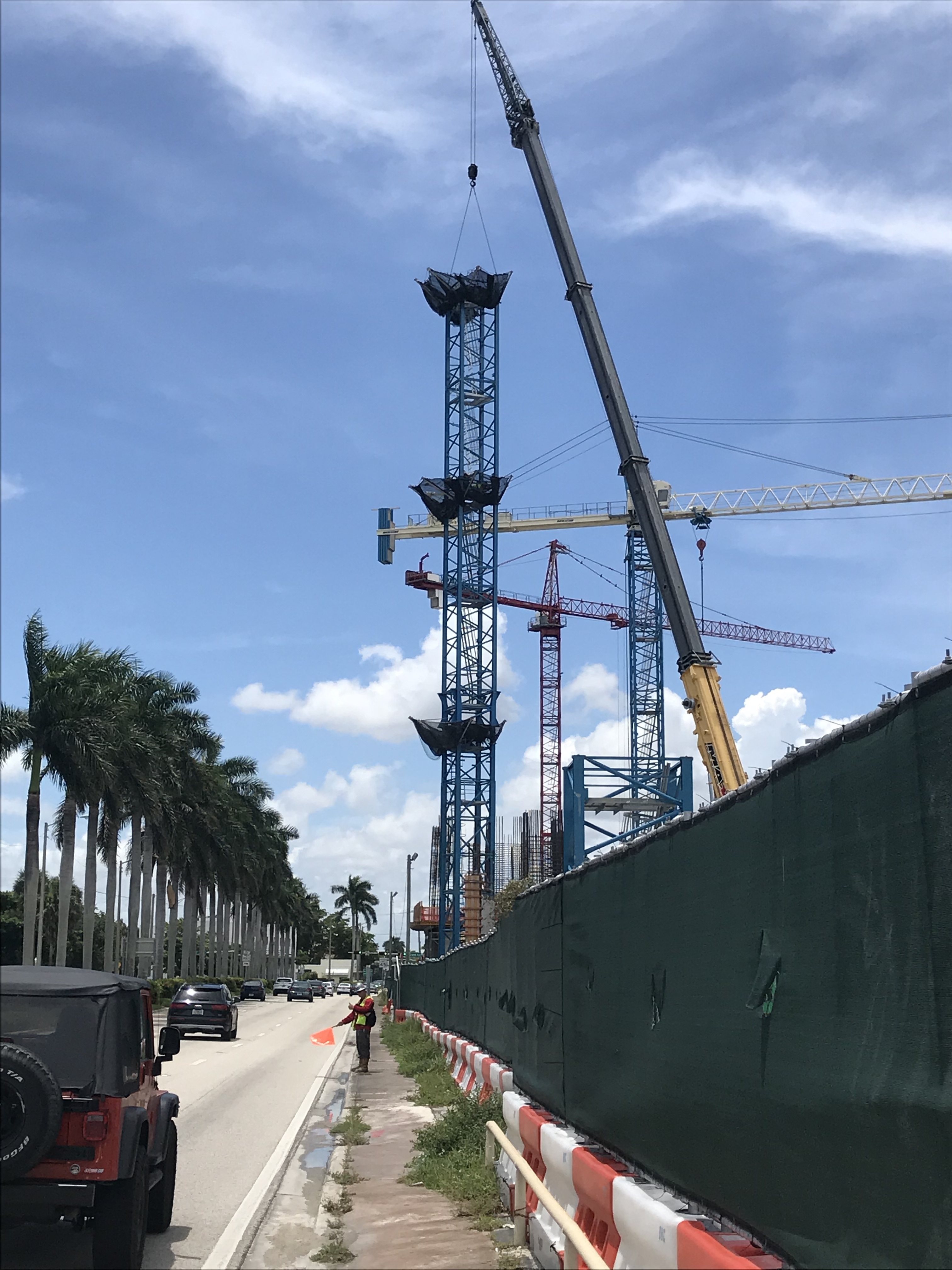Concrete, Cranes—and Cars?
Balfour Beatty recently launched an industry-leading safety initiative to incorporate live traffic as a fifth fatal risk into our planning and operations. By expanding OSHA’s long-standing “Fatal Four,” Balfour Beatty has taken a progressive step forward in addressing a growing crisis of serious work zone incidents and fatalities.
Balfour Beatty’s proactive leadership in identifying and prioritizing live traffic hazards represents a monumental step forward for the safe construction of vertical buildings. With this enhanced focus, Balfour Beatty aims to address the unique and differentiated live traffic hazards on vertical buildings projects to better protect our workforce, the public and ultimately the clients we serve.
On infrastructure projects such as highways and bridges, live traffic dangers stem from two major sources: the traveling public and construction activities, each potentially posing serious hazards to one another. On vertical buildings projects – especially those that are under renovation and partially occupied – live traffic hazards can be more nuanced, requiring contractors to comprehensively consider the entire ecosystem of traffic activities occurring inside and outside the jobsite.
By-the-Books Logistics Plans
Consider, for example, construction work on an occupied school campus. In California, where Balfour Beatty proudly ranks as the No. 1 education builder (Engineering News-Record, 2024), our project teams encounter numerous forms of live traffic hazards – all of which are critical to incorporate into our site logistics plans to keep our workforce and the public safe.
From parent pick-up lines and school bus lanes to the arrival and departure of school faculty and staff—and even public attendance at community, civic and cultural events sometimes held on campuses—contractors must account for a wide range of traffic types and patterns. Our teams think critically not only about the live traffic activities of our clients, but also those of the buildings’ end users: the clients of our clients.
Pedestrian foot traffic is also of paramount concern. Young children, often curious about construction, are especially prone to accidentally or even intentionally wandering into work zones where construction traffic could put them at serious risk. Balfour Beatty maintains a strict policy of locking our gates to prevent such an occurrence.
“Through our comprehensive logistics plans that are continually updated over a project lifespan, we strive to create complete separation of our activities from operational campus areas,” says John Baradin, safety, health and environment director in California. “We intentionally locate access points for our trade partners within laydown areas on the opposite end of campus to further separate construction traffic from school traffic.”
First, Do No Harm
Like countless K-12 and higher education facilities, many healthcare facilities in the U.S. were originally constructed several decades ago. Renovations are often preferred over new construction to maintain operational continuity, modernize outdated systems such as HVAC, electrical and medical gas or reconfigure spaces for evolving models of care.
Healthcare clients seek out a construction partner like Balfour Beatty that successfully minimizes or eliminates any disruption to the patients’ care and overall experience. This includes the safe management of construction traffic, as well as the diverse types of vehicular and pedestrian traffic a healthcare facility may draw as part of its everyday operations.
Senior Vice President and Business Unit Leader in North Texas, Steve Dillon, has encountered live traffic challenges on numerous healthcare projects. Since 1996, Balfour Beatty has served Texas Health Resources (THR) on hundreds of projects on the Texas Health Harris Methodist Hospital campus in Fort Worth, Texas. Throughout projects encompassing every aspect of healthcare construction – from cafes to towers to maternity wings – Balfour Beatty’s longstanding partnership with THR has been built on the pillar of Zero Harm.
“On every healthcare project, we prioritize separating the employees of the hospital from our work, but we also have to take into account emergency responders, patients and the loved ones visiting the patients who may or may not be familiar with the facility,” says Steve. “Clear and consistent wayfinding is critical, because any source of confusion or misdirection can delay care, cause stress or even lead to safety incidents.”
The Taller the Structure, the Deeper the Safety Foundation
While urban, high-rise projects may encompass many product types from corporate offices to boutique hotels, multifamily housing and more, one core principle remains constant for all: downtown settings are replete with live traffic hazards that could impact the safety and wellbeing of our workforce or that of the public.
 Urban settings draw a wide variety of visitors, and with them, types of traffic. From patrons of retail amenities and visitors of public attractions to workforce commuters, public transit, commercial and service vehicles and more, city environments never slow down. To make matters more complex, many urban municipalities prohibit partial or full lane closures to reduce traffic congestion and the impact of construction on local businesses and residents.
Urban settings draw a wide variety of visitors, and with them, types of traffic. From patrons of retail amenities and visitors of public attractions to workforce commuters, public transit, commercial and service vehicles and more, city environments never slow down. To make matters more complex, many urban municipalities prohibit partial or full lane closures to reduce traffic congestion and the impact of construction on local businesses and residents.
This presents challenges for the safe coordination of material deliveries, utility relocations, facade installations, equipment staging, pedestrian protection, debris removal and other critical activities. At Balfour Beatty, we believe no detail is too granular to incorporate into a project’s Maintenance of Traffic (MOT) plan to keep our workforce and the public safe, even down to the turning radius of delivery trucks.
Our Knox Street Development project in Dallas, Texas, for example, is surrounded on three of its four sides by live traffic from nearby businesses, residential properties and retail destinations with an active park on its fourth side. While many urban, high-rise projects are colloquially described as “sidewalk-to-sidewalk,” Knox Street doesn’t even fit that bill; it abuts directly to adjoining streets, creating imminent live traffic hazards mere inches away from the project perimeter for personnel such as flaggers. Because there is no room for parking within the jobsite, every day, anywhere from 300 to 500 of our valued craft and trade partners must walk several city blocks to the jobsite. Our site safety plan takes the full spectrum of these hazards into account, along with ensuring the safety and wellbeing of every member of the public who comes in contact with our work.
“When it comes to the effective management of live traffic hazards, every project is truly a snowflake with a unique matrix of stakeholders, processes and requirements, and it must be planned as such,” says Steve.
A Master Class in Live Traffic Management
Members of our $780 million Broward County Convention Center & Hotel Expansion (BCCCH) project in sunny Fort Lauderdale, Florida might not describe the job as a snowflake, but they’d be quick to impart the immense and wide-ranging live traffic challenges the team has successfully navigated over the last five years of construction.
 The project expands the Broward County Convention Center to a total of 2.3 million square feet by adding a 1.3-million-square-foot Omni Hotel, more than 525,000 square feet of meeting space, a three-story visitor’s bureau, a 36,000-square-foot central energy plant and other amenities. While the project scope alone is a tremendous feat of construction, what makes it even more impressive is our successful and safe work in and around an operational Convention Center replete with live traffic hazards.
The project expands the Broward County Convention Center to a total of 2.3 million square feet by adding a 1.3-million-square-foot Omni Hotel, more than 525,000 square feet of meeting space, a three-story visitor’s bureau, a 36,000-square-foot central energy plant and other amenities. While the project scope alone is a tremendous feat of construction, what makes it even more impressive is our successful and safe work in and around an operational Convention Center replete with live traffic hazards.
In fact, the very front door of the Convention Center is nestled into the middle of our jobsite. To create safe access into the building for the hundreds of thousands of travelers who visit this premier destination annually, Balfour Beatty constructed a fully barricaded road with signage for public use that spans just under half a mile from the north end of the jobsite.
This solution was chosen, according to Operations Director Michael Hite, because it presented the least operational impact and the greatest safety benefit to the client, Matthews Southwest, its end users and the local community. When construction is complete, Balfour Beatty will pave a permanent road adjacent to the temp road.
The project’s waterfront location adds even greater complexity to site traffic management. The south side of the project is bordered by Port Everglades, which is a major international seaport that includes multiple cruise terminals, cargo berths and administration buildings that house the U.S. Department of Homeland Security.
Balfour Beatty proactively schedules material deliveries and equipment staging around the cruise ship arrivals and departures and the immense volume of live and pedestrian traffic they draw. Additionally, BCCCH attracts hundreds of thousands of travelers for the annual Fort Lauderdale International Boat Show, which is the world's largest in-water boat show.
Michael, who has over four decades of industry experience, brings specialized expertise in large-scale projects located in dense, urban areas and associated live traffic management. Having worked with the client, Matthews Southwest, on the marquee Omni Dallas Convention Center Hotel project, Michael possesses a deep understanding of the client’s priorities for their end users and tailors his construction strategies accordingly.
 At BCCCH, Michael prioritizes wayfinding to protect the significant volume of pedestrian traffic around the jobsite as well as the complete separation of construction activities from pedestrian access.
At BCCCH, Michael prioritizes wayfinding to protect the significant volume of pedestrian traffic around the jobsite as well as the complete separation of construction activities from pedestrian access.
“By far, our biggest exposure is our proximity to pedestrians traveling on foot who are often unfamiliar with the area or distracted by new surroundings,” asserts Michael. “We instituted a non-negotiable 24/7 gate guard policy to ensure pedestrians don’t accidentally wander into the jobsite, and those gates are always closed or locked.”
In lieu of relying on flaggers, another proactive Zero Harm strategy the BCCCH team has employed is the erection of physical barricades – whether concrete, water or sand – along with designated drive lanes. It’s a winning strategy Michael has long employed on his projects.
“Any battle between a man and machine is a battle a man will not win,” attests Michael. “I’ve always been a proponent of fully eliminating the worst-case scenario no matter what the risk.”
While Michael says BCCCH has been amongst the most challenging projects in his career when it comes to live traffic management, he is quick to credit the entire project team for their proactive planning, seamless communication and collaboration with all stakeholders—strategies that are keeping our people and the public safe.
Special Projects, Shared Safety Challenges
Many of Balfour Beatty’s projects in urban areas fall under our special projects realm. From quick-turn retail fit-outs to tenant improvements in mixed-use developments and new construction of upscale corporate interiors, special projects may be smaller in scale, but they face many shared live traffic challenges with large-scale construction.
Any urban project – whether encompassing 600 feet or 60,000 – requires contractors to coordinate just-in-time deliveries. If the building is occupied, which is often the case for special projects teams, the deliveries must be coordinated and communicated across every individual tenet. Compounding this challenge, curb space is typically limited, streets may prohibit staging or lane closures and crews often navigate around active foot traffic, retail patrons, ride-share pickups and daily business operations—all while maintaining strict safety and noise control standards.
Nighttime operations, which are a mainstay of special projects, pose even greater risks for our workforce and the public and require heightened attention and enhanced safety planning. Unloading activities in poorly lit areas increase risks for flaggers, drivers and laborers. Low-light conditions reduce public visibility and awareness, may enhance the dangers of existing blind corners or even create new blind spots.
“You have to have a crystal-clear plan on how you’re going to access in and out of a building, because that’s where the risk is highest in dealing with the public,” affirms Steve.
A prime example of these challenges is the 2000 McKinney Repositioning project—a multi-phase renovation of a high-end, Class A, multi-tenant office building in Dallas, Texas. The project scope included lobby and exterior courtyard upgrades, ten elevator cab renovations and a new reception desk.
To maintain separation between construction activities and the building occupants throughout construction while not diminishing the overall aesthetic, the project team installed a unique and high-end temporary barrier system using coroplast and poly curtains. Through enhanced communication and coordination with the facilities team, Balfour Beatty ensured that operations continued safely and securely, minimizing disruption while navigating the complexities of an active, urban environment.
Uncovering the Hidden Hazards of Greenfield Sites
While large greenfield sites may appear to pose fewer live traffic challenges, Chris Diaz, vice president of loss prevention in the Southeast, argues that their complexities and inherent risks often rival those of downtown projects—especially when multiple contractors are working on the same site.
On many hospitality projects in Florida, our teams work alongside other major general contractors, each with their own workforce, schedules, material deliveries, unique equipment operations, inspections and more. Daily communication with the other contractors is essential to eliminate and mitigate the live traffic risks of all construction operations.
“An 80-acre project site is a mini-city, and you often have to figure out how to get people from point A to point B in constant coordination and communication with other contractors,” describes Chris.
Shared Roads, Shared Responsibility: Partnering for Safer Projects
 Although Balfour Beatty has made impactful strides in live traffic safety, we can’t reverse industry trends alone. Our project partners are essential to the successful management of live traffic hazards, both inside and outside the jobsite.
Although Balfour Beatty has made impactful strides in live traffic safety, we can’t reverse industry trends alone. Our project partners are essential to the successful management of live traffic hazards, both inside and outside the jobsite.
On the Jacksonville Transportation Authority’s Autonomous Innovation Center, part of a larger program known as the Ultimate Urban Circulator (U2C), Balfour Beatty engaged off-duty police officers to secure intersections and ensure public safety during the installation of autonomous vehicles. The owner, Jacksonville Transportation Authority, made this investment in Zero Harm possible and was committed to protecting the public throughout the duration of these operations.
Balfour Beatty also coordinated closely with local police on the Gables Station project in Miami, Florida—a 1.3-million-square-foot mixed-use development that required three tower cranes during peak construction. Because adjacent roads had to remain open during crane dismantling – an inherently dangerous operation – the team proactively partnered with law enforcement to manage live traffic.
Their collaboration proved incredibly beneficial to both the project team and the public. As the team prepared to conduct hoisting operations to remove the cranes’ jibs, counterweights and mast sections, the police officers moved from their station at local intersections to direct traffic to the outermost lane. The result was the safe and successful dismantling of all three cranes—a testament to the power of partnership to achieve Zero Harm.
Advancing Zero Harm
At Balfour Beatty, Zero Harm is a never-ending journey marked by continued improvement, exploration of new ways of planning and working and implementation of innovative technologies and processes that allow everyone to go home safely at the end of each day. Live traffic is by no means a new risk to our business or industry, but our acknowledgement as a fifth fatal risk represents a bold step forward and one we are excited to endeavor on vertical buildings projects from coast-to-coast.